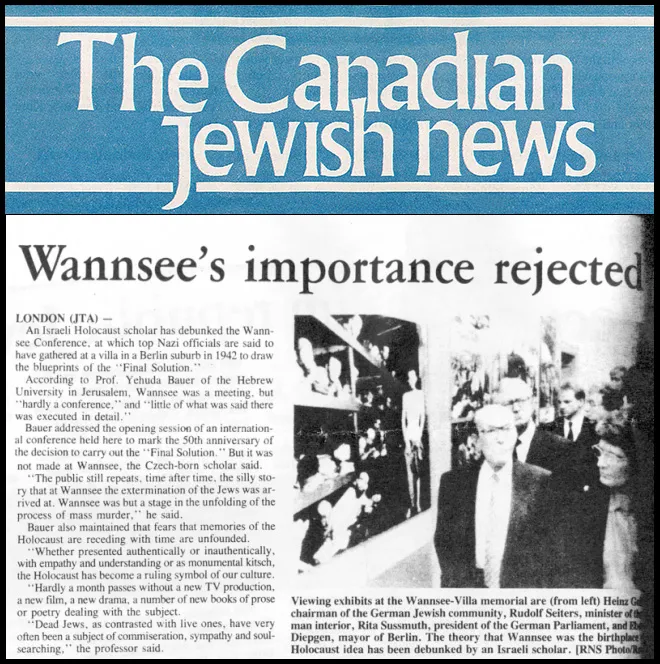“The silly story” of Wannsee
A release from the Jewish Telegraphic Agency, published ten days after the worldwide celebration of the anniversary of the Wannsee “protocol” of January 20, 1942, announced that, for Yehuda Bauer, professor at the Hebrew University of Jerusalem, the meeting at Wannsee could not have had the significance that the media persisted in ascribing to it, according to which the Germans decided, on that day, to exterminate the Jews. Y. Bauer considered that this was even a “silly story”. From the beginning of the 1980s the so-called Wannsee thesis had been progressively forsaken by historians and was definitively abandoned at the Stuttgart conference (May 3-5, 1984). But the general public is kept in the dark about these rectifications, which constitute so many involuntary tributes to the revisionists.
In France, the media drum-beating about Wannsee continues to find an echo even in such places as the postman’s calendar for 1992; in the compendium of historical dates the reader discovers:
January 20 [1942]: The Nazis adopt “the final solution” for the Jews, whom they deport and execute en masse.[1]
But here, in its entirety, is the release from the Jewish Telegraphic Agency (London) as reproduced in the Canadian Jewish News of January 30, 1992 under the headline “Wannsee’s Importance Rejected”:
LONDON (JTA) –
An Israeli Holocaust scholar has debunked the Wannsee Conference, at which top Nazi officials are said to have gathered at a villa in a Berlin suburb in 1942 to draw the blueprints of the “Final Solution.”
According to Prof. Yehuda Bauer of the Hebrew University in Jerusalem, Wannsee was a meeting, but “hardly a conference,” and “little of what was said there was executed in detail.”
Bauer addressed the opening session of an international conference held here to mark the 50th anniversary of the decision to carry out the “Final Solution.” But it was not made at Wannsee, the Czech-born scholar said.
“The public still repeats, time after time, the silly story that at Wannsee the extermination of the Jews was arrived at. Wannsee was but a stage in the unfolding of the process of mass murder,” he said.
Bauer also maintained that fears that memories of the Holocaust are receding with time are unfounded.
“Whether presented authentically or inauthentically, with empathy and understanding or as monumental kitsch, the Holocaust has become a ruling symbol of our culture.
“Hardly a month passes without a new TV production, a new film, a new drama, a number of new books of prose or poetry dealing with the subject.
“Dead Jews, as contrasted with live ones, have very often been a subject of commiseration, sympathy and soul-searching,” the professor said.
On February 14, 1990 the judges Diet, Pluyette and Breillat dismissed R. Faurisson’s suit against G. Wellers. Our journal had reported[2] on the manipulation in which those judges had engaged in their alleged reproduction of the Wannsee “protocol”, and this to accredit a thesis abandoned since 1984 and today described as “silly” by a leading light of the exterminationist school. It would be interesting to know the reaction of Messrs Robert Diet, Gérard Pluyette and Yves Breillat to Y. Bauer’s statement.
May 1, 1992
_______________
[1] L’Almanach du facteur, Eyrolle 1992.
[2] Revue d’histoire révisionniste, n° 3 (November-December 1990 – January 1991), p. 204-205 and n° 4 (février-mars-avril 1991), p. 192-193.

